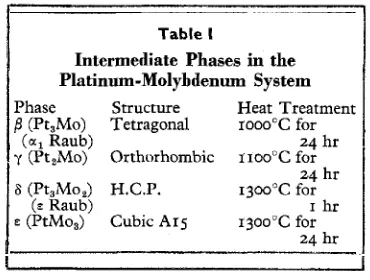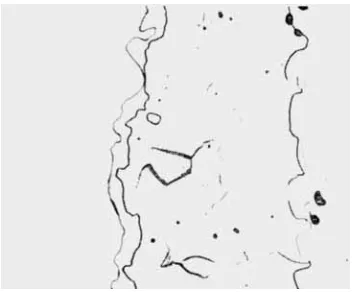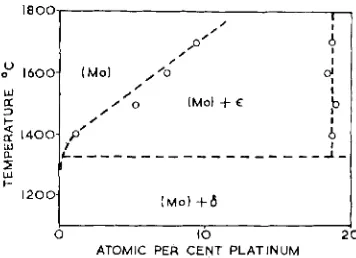The
Platinum-Molvb
Jdenurn
JTHE FORMATION OF INTERMEDIATE PHASES
By G.
L.
Selman,
B S ~ .Research Laboratories, Johnson Matthey & Co Limited
Although platinum-clad molybdenum is used extensively as a material for handling molten glass, surprisingly little is known about the constitutional relationships in this refractory metal binary system. Recent work in the Johnson Matthey Research Laboratories has conjrmed that the pub- lished equilibrium diagram is incomplete and that four intermediate phases are formed at high temperatures. This work has provided a better understanding of the behaviour of platinum-clad molybdenum equipment under operating conditions in the glass industry.
Advances in glass technology, leading in many instances to increased handling temper- atures, are placing an ever-increasing burden upon glass handling equipment. Emphasis is being placed more and more on the use of composite materials, such as molybdenum with an outer cladding of platinum, which take advantage of both the excellent high temperature mechanical properties of the refractory metals and the outstanding oxi- dation resistance and general chemical in- ertness of the platinum metals.
While the stirrers, mandrels and electrodes constructed of platinum-clad molybdenum have useful lives at temperatures of up to 12oocC, at higher temperatures, although this combination represents the most economic and technically satisfactory choice, inter- reaction between the two metals takes place, so that the life of the platinum sheath is largely dictated by the rate at which molyb- denum diffuses through it and by the effect of the intermediate alloy layers so formed upon its integrity.
It is therefore becoming increasingly im- portant to the metallurgist concerned with this problem that he has a t his command sound information concerning the binary alloys of the platinum metals with the refractory metals at temperatures up to
15ooOC. Such information is not generally available in the literature.
During the course of recent diffusion studies made in these laboratories on molybdenum rods mechanically clad with platinum sheaths, metallographic evidence confirming the existence of four intermediate alloy phases in this complex binary system has been obtained. The solubility of platinum in molybdenum in the temperature range 1400' to 170oCC has also been determined by direct analysis of the microstructure of two molyb- denum-rich alloys made by conventional alloying techniques. The solubility has been found to increase rapidly with temperature in this region. The results of this investiga- tion bear interesting comparison with the previous studies made on this system.
Previous Constitutional
Work
The earliest reference to the platinum- molybdenum system appears to be that due to Dreibholz (I) who suggested that about 16 weight per cent molybdenum should be soluble in platinum at the eutectic temper- ature, this figure decreasing to less than two per cent at room temperature. Hultgren and Jaffee (2) studied electron beam melted alloyscontaining up to 50 atomic per cent molyb- denum after annealing at IOOO"C. The X-ray
Fig. 1 Tentative constitutional diagram of the molybdenum- platinum system as proposed by Knapton (6). The present studies have confirmed that two ndditional intermediate phases exist, and have also shown that the solubility of platinum i n
higher than the diagram would suggest at temperatures above 1400°C
260C
molybdenum is considerably 2 2 0 c
U
w I800
a
2) b
4 Z' u1 n
3
1400
I-
1000
600
patterns that were obtained showed a single face centred cubic phase, with lattice con- stants near to that of platinum, for all compositions.
The first systematic investigation was carried out by Raub (3) who studied arc melted alloys. He observed very little solubility of platinum in molybdenum but found that molybdenum was appreciably soluble in platinum. He detected a tetragonal distortion of the face centred cubic lattice in platinum-rich alloys containing more than about 25 atomic per cent (14 weight per cent) of molybdenum to give an axial ratio greater than 1.0. This new phase, denoted a l ,
separated from the terminal solid solution below 14oo0C. A hexagonal close packed E
phase was found to form at about Pt3M02, with a very wide composition range. Further references to this hexagonal phase were made by Greenfield and Beck (4) and Nishimura (5). The latter author constructed an equilibrium diagram on the basis of melting
LIQUID Mo
+\
I
M o + E
b b
b
2 r
Platinum Metals Rev., 1967, 11, (4) 133
KNAPTON RAUB
0 0 Pt
A A eta,
v V E + P t
+
0 Eb D €
B
X MELTING POINTS n aI
ATOMIC PER CENT PLP
-x-4 * o a 0 0
a
\+a;
..
0O D 0
8 0 I
NUM
point determinations, X-ray analyses and microscopical examinations. Platinum-rich alloys were shown to form via a peritectic reaction,
Liquid f p
z
ciand molybdenum rich alloys formed via a eutectic
Liquid 2
p
+
y (Mo).Nishimura ascribed the composition PtMo to the hexagonal phase, and his diagram suggests an appreciable solubility of platinum in molybdenum at the eutectic temperature.
Nishimura did not account for the tetra- gonal phase in his work, and the constitutional diagram representing the best combination of evidence available at that time is that due to Knapton (6), reproduced in Fig. I. It is obvious that no attempt has been made to determine the phase boundary positions accurately, and this diagram can only be regarded as tentative.
to have observed a new phase, stable only at high temperatures, at the molybdenum-rich end.
Figure I illustrates the lack of previous experimental work in this region, and it is not too surprising that such a phase remained undetected. Thc phase was very hard, and readily observable in both arc melted alloys and diffusion couples heat treated at 1400' and
ISOOT.
It decomposed on heating for 30 hours at 1200°C.Rooksby and Lewis (8) conducted the most recent study of this system. During their experiments they heated fine platinum-clad molybdenum wires under controlled condi- tions which produced the intermediate phases in turn on the coating surface, from which X-ray diffraction patterns were then obtained. The compositions of the phases so formed were not determined directly, but were approximately fixcd by analogy with other isostructural compounds from the X-ray dif- fraction data.
Table I, which is reproduced in part from Rooksby's paper, lists the phases identified and some typical heat treatments which were required to produce them at the coating surface.
Table I
Intermediate Phases in the Platinum-Molybdenum System Phase Structure Heat Treatment /I(Pt,Mo) Tetragonal rooo"C for
(a, Raub) 24 hr
y (Pt,Mo) Orthorhombic r ~ o o " C for 24 hr
6 (Pt,Mo,) H.C.P. 13ooOC for
(E Raub) I hr
P (PtMo,) Cubic A15 13oo0C for
24 hr
Rooksby and Lewis thus identified two phases in addition to those originally pro- posed by Raub, the orthorhombic y and the $-tungsten structure designated E. Both of
these phases had very narrow composition ranges, judging from the small variations observed in their lattice spacings. The molybdenum-rich phase due to Kirner is thus
in all probability PtMo,, isostructural with the P-tungsten phase previously observed in iridium-molybdenum alloys (9).
Experimental Diffusion Studies at
High
TemperaturesPlatinum-molybdenum diffusion couples have been examined extensively in these labora- tories in recent times as part of a general investigation into the uses of platinum at high temperatures. Pressure bonded sheets have been found to be unsuitable for long term annealing above 1300"C, due to a tendency for the components to peel apart, and the test specimens which formed the basis for the major part of this work were manufactured from spectrographically pure Murex molyb- denum rod and high temperature grade platinum tubing of 0.060 inch wall thickness, containing typically about 0.0075 per cent total impurity.
Short lengths of the molybdenum rod were vacuum sealed into the close fitting platinum tubes, and the two mctals were then bonded by lightly hot swaging the assemblies at 1200°C. The annealing tests were conducted in air at 1400°C. The specimens were freely supported in the hot zone of a mullite tube furnace at this temperature for periods up to
2000 hours, following which they were cooled
in air and sectioned for metallographic examination. These composite specimens were difficult to etch chemically because of the vastly differing response of the two metals to the etching solution. The microstructures were revealed most clearly by cathodically etching the polished sections in a stream of low pressure argon.
Microstructure and Constitution
of
the Diffusion Zones
Diffusion couples prepared in the manner described in the foregoing section maintained their integrity throughout the annealing cycle, and no interfacial failures occurred. Fig. 2 shows the diffusion zone formed in a
platinum-clad molybdenum specimen by annealing for 1100 hours at 14ooOC. The Table II
Electron Probe Microanalyses of the Four Intermediate Phases
Wt.yo At.?, Wt.:/, At.o/b
Phase Mo
rt
I 67.5 81.0 31.5 18.5
I1 34.0-45.0 51.1-62.5 54.4-65.0 37.0-47.8
I11 26.5 42.6 75.0 59.6
Fzg. 2 A molybaknum-platinum interlace after annealing for 1100 hours at 1400"C, showing the four intermediate alloy layers formed during the
heat treatment. x 200
1600
1
0 I00 2 0 0 3 0 0
11400 I t 1 2 0 0
- 1000 HV
-
1 5 0 0
- 8 0 0 I
t
6ooI 200
00
eo c z
6 0
u"
[L
w
P
I
4o t- 2 0
g
!?0
-TRAVERSED LENGTH (MICRONS)
Fig. 4 Electron probe scans for molybdenum and platinum across the interface shown i n Fig. 1 . The
intermediate alloy layers are well dejined and can be accurately related to hardness and microstructure
Platinum Metals Rev., 1967, 11, (4) 135
intimately convoluted nature of the inter- mediate alloy layers, which makes it difficult to isolate and follow the somewhat erratic formation of the phase adjacent to the molybdenum, was a noteworthy and fairly typical feature of the microstructures ob- served during the course of this work. Rooksby and Lewis showed from their X-ray data that the structural transitions from one phase to the next occur with the minimum of atomic movement and alteration of lattice spacings, in spite of considerable changes in composition. This close relationship between the phases, which resemble a series of dis- crete but ordered solid solutions, could well account for their somewhat intimate associa- tion within the microstructure.
On close scrutiny it was possible to resolve four intermediate phases in the diffusion zone, in complete agreement with the findings of Rooksby. These phases are defined more clearly in the microhardness and microprobe traverses made across the diffusion zone, shown in Figs 3 and 4.
The curve of microhardness across the diffusion zone is remarkably similar in shape to those obtained by Kirner, who studied diffusion couples annealed at 1400' and 1500°C. This worker suggested that the peak
at the molybdenum-rich end of the traverse was due to his new phase, and identified the second peak with the hexagonal phase dis- covered by Raub. Comparison of the micro- hardness curve with the microprobe scan strongly suggests, however, that the hexagonal
6 phase is more closely related to the mini- mum between the two peaks, and that the second peak occurs within the orthorhombic y phase discovered by Rooksby.
The microprobe traverse confirms Raub's finding that the terminal solubility of platinum in molybdenum is small at intermediate temperatures, and highlights the extensive composition range of the hexagonal phase.
In an attempt to establish the compositions of the intermediate alloy layers with some accuracy, point analyses were made at 20 kV
on each of the four phases shown in the Fig. 3 A microhardness scan made across the inter-
Fig. 5 The substantially single phase microstructure of a 20 per c e ~ platinum-molybdenum alloy quenched after annealing for 7 hours at 1850°C. x 200
Fig. 6 The 20 per cent Fig. 7 The pearlitic structure platinum-molybdenum alloy formed by anneuling the 20 quenched after annealing for per cent platinum-molybdenum 7 hours at 170O"C, showing the al1o.y for 165 hours at 1250°C. typical high temperature x 750
duplex microstructure. x 200
diffusion zone. The radiations used were to the compositions PtMo3, PtMo, Pt,Mo, PtLa and MoLa. After correction for atomic and Pt,Mo, a sequence which is not well number and absorption effects the values supported by any of the previous investi- given in Table I1 were obtained. gations.
The Solubility of Platinum
in
Molybdenum
The form of the molybdenum-rich end of the binary system envisaged by Knapton Wt.yo At.?, Wt.:/, At.o/b (Fig. I) appeared from our own results, and from those of Kirner and Rooksby, to be seriously in error.
I 67.5 81.0 31.5 18.5
Alloys containing 10 and 20 weight per cent
I11 26.5 42.6 75.0 59.6
IV 28.5-24 31.6-39 77.0-81.3 62.2-67.6
The analyses are quoted to an estimated accuracy of & 3 per cent. The composition ranges obtained for phases I1 and IV at
1400°C agree remarkably well with those shown on the tentative diagram due to Knapton (Fig, I) for the hexagonal (E) and
tetragonal (q) intermediate phases.
Taken in order, however, they bear little resemblance to the sequence of structures reported by Rooksby, with the possible exception of phase I. Taken in isolation, the analytical results suggest that the atomic arrangements of the four phases correspond
platinum were prepared, from starting materials of similar purity to those used for the diffusion studies, in an argon arc furnace. The melted buttons were turned and remelted several times, and finally heat treated for seven hours at 1850°C to ensure homo- geneity. Samples from each ingot were then annealed at temperatures ranging from I IOO to 185o"C in an argon atmosphere for long periods, quenched and prepared for metallo- graphic examination.
Fig. 8 Boundary curves for the molybdenum-rich terminal soEid sobtion and the high temperature E
phase as determined by electron probe microanalysis
of alloys in the duplex region
phase solid solution at the soaking tempera- ture. Untreated filings taken from this specimen gave a diffraction pattern corres- ponding to a body centred cubic structure with a lattice parameter a == 3.143& a value slightly lower than that of pure molybdenum. At lower temperatures a second phase separated from this terminal solid solution (Fig. 6) which in turn decomposed at tempera- tures below about 1300OC to yield the pearlitic microstructure shown in Fig. 7. X-ray diffrac- tion showed that the high temperature duplex microstructure was composed of body centred cubic and cubic @-tungsten) structures, the latter corresponding to the E phase described
by Rooksby. The low temperature duplex structure consisted of a body centred cubic and a hexagonal phase corresponding to that designated by Rooksby as 6.
The individual phases present in specimens quenched from temperatures above 1300'C
were fully resolvable under the electron probe microanalyser, and their compositions were determined. The analytical results have been plotted in Fig. 8, which illustrates the very rapid increase in the solubility of plati- num in molybdenum between 1400' and
17oo0C, and the constancy of the high temp-
erature E phase composition over this region.
The E phase decomposes eutectoidally at 1325' i z j"C, according to the metallographic evidence obtained on the two alloys examined.
Practical Significance of
the
High
Temperature
Phase Relationships
When attempts are made to use the desirable properties of platinum-clad molybdenum at temperatures above 1300T failure tends to take place in a characteristic manner. Large distortions of the sheath begin to occur, giving the component a "blistered" appear- ance, and eventually the sheath cracks, so that
l 8 0 0 , I t
( M o ) i-&
1 2 0 0
0 10 2 0
ATOMIC PER CENT PLATINUM
catastrophic oxidation of the molybdenum can take place without hindrance. Such failures are rarely associated with the complete diffusion of molybdenum to the outer platinum surface.
From laboratory experience with the manu- facture of test composites it has become quite clear that unless special precautions are taken it is difficult to maintain a coherent interface during annealing when the heat treatments are carried out above 1300°C, and that this difficulty is mainly due to high interface strains associated with the formation of the high temperature intermetallics in the difi- sion zone. The formation of these phases could similarly account for the distortions ob- served in glass handling equipment used at high temperatures.
Further theoretical work on this and other refractory metal platinum systems which are potentially useful at high temperatures would thus be of considerable practical value to metallurgists and engineers concerned with plant design and development.
References
I L. Dreibholz, Z. phys. Chem., 1924, 108, 5 2 R. Hultgren and R. I. Jaffee, J . Appl. Phys.,
3 E. Raub, Z . Metallk., 1954, 45, 23
4 P. Greenfield and P. A. Beck, Trans. A . I.M.E.,
5 H. Nishimura, Nippon Kinzoku Gakkai-Si,
6 A. G, Knapton, Planseeber., 1959, 7, 2
7 K. Kirner, Metall, 1962, 16, (7), 672
8 H. P. Rooksby and B. Lewis,J. Less-Common
9 A. G. Knapton,
3.
Inst. Metals, 1958-59,87,28 1941, 12, 5011956,206, 265
1958, 22,425
Metals, 1964, 6, 451




